Top Texas Parks for Horseback Riding
Texas State Parks provide some of the most diverse landscapes for visitors, including all levels of riders. With different terrain and landscapes, find out about some of the top Texas parks for trail riding below.
Dinosaur Valley State Park
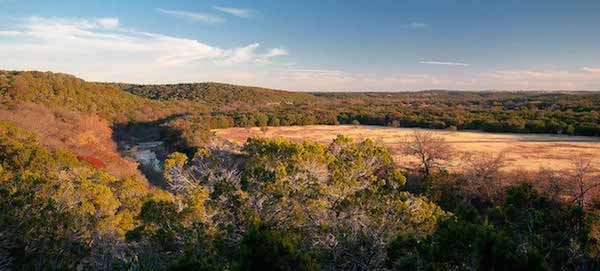
View overlooking the Valley and Paluxy River at Dinosaur Valley State Park. Photo Courtesy Texas Parks and Wildlife Department © Chase A. Fountain
Located southwest of the Dallas/Fort Worth metroplex in Glenrose, Texas, Dinosaur Valley State Park is distinct in its landmarks. A National Natural Landmark, Dinosaur Valley State Park’s name is derived from its housing of Dinosaur tracks in the riverbed of the Paluxy River. These Dinosaur tracks were formed over 113 million years ago, and were discovered by George Adams in 1909. In 1972, Dinosaur Valley State Park was opened to preserve these tracks and allow people to visit, learn, and enjoy them.
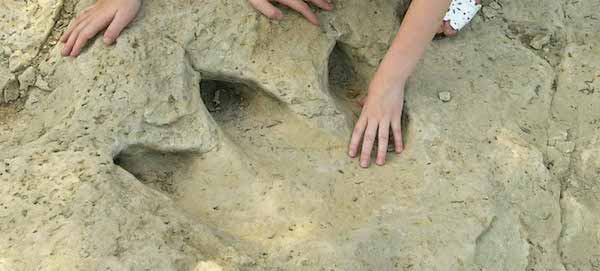
One of the many Dinosaur footprints found at Dinosaur Valley State Park. Photo Courtesy Texas Parks and Wildlife Department © Chase A. Fountain
Dinosaur Valley is not only home to these ancient Dinosaur tracks, but also to a variety of plant and animal species. During your visit, you may encounter many kinds of animals, ranging from deer and armadillos to small rodents and wild turkeys. Dinosaur Valley State Park is also home to two endangered bird species: The Golden-Cheek Warbler and the Black-Capped Vireo. There are many types of trees and shrubs located in the state park, including cedar elm, American elm, walnut, live oak, and Texas oak trees.
There are many activities available while camping at Dinosaur Valley State Park, including hiking, swimming, fishing, and horseback riding. In the South Primitive Area of the park, there are 100 acres of unmarked trails set apart specifically for equestrian use. These trails are wooded and some are semi-rocky, but the views and experiences are incredible and well worth trail challenges. With the Paluxy River running through the park, horses and their owners are able to walk along the riverbed and enjoy the beautiful landscapes, which may even include some dinosaur tracks!
While horseback riding in Dinosaur Valley State Park is for day-use only, many equestrians would tell you that it is well worth the trip. If you are bringing your own horse, there is available trailer parking with restrooms and showers nearby the day-use parking area. Horses are allowed to drink the river water, but people are advised to bring their own drinking water. The park charges seven dollars per day for adults (age 13 and over), while children 12 and under can get in for free.
Guided tours are also available, and are hosted by Eagle Eye Ranch Carriage Company. This company provides all of the horses needed, and offers a 30 minute and a one hour guided trail ride through Dinosaur Valley State Park. The 30-minute trail ride is aimed at beginner riders, while the one hour trail ride has a minimum age of eight years old and targets a more experienced rider.
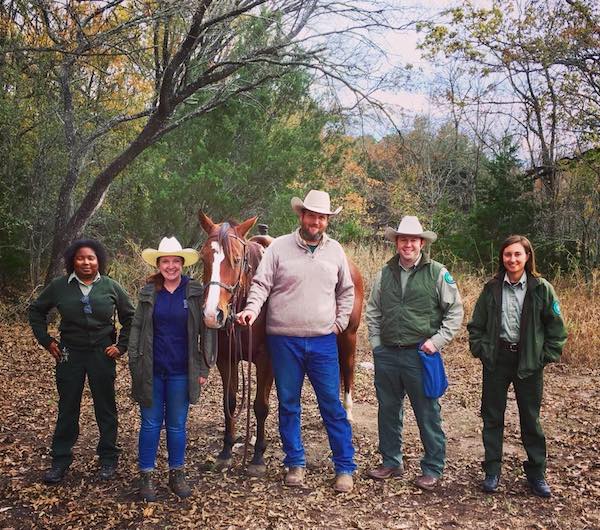
Eagle Eye Ranch Carriage Company with Dinosaur Valley State Park Rangers. Photo from Eagle Eye Ranch Carriage Company.
Find out more about Dinosaur Valley State Park.
Big Bend Ranch State Park
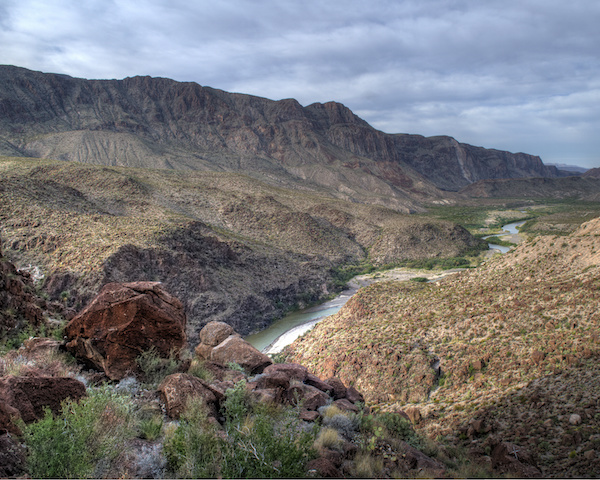
View overlooking Big Bend Ranch State Park from a canyon. Photo Courtesy Texas Parks and Wildlife Department © Chase A. Fountain.
Designated as Texas’ biggest state park, Big Bend Ranch State Park is located in Presidio, Texas, along the Rio Grande on the U.S.-Mexico border. This state park is home to 238 miles of trails in the Chihuahuan Desert and contains beautiful views of mountains, canyons, and waterfalls. The elevation in the desert ranges from 2,300 feet to 5,135 feet in the mountains.
Being located in the desert area, Big Bend Ranch State Park is home to a variety of animals. There have been over 16 different bat species found living in the area, and many types of snakes have been seen as well. On rare occasions, campers have spotted mountain lions and black bears that find their homes in the mountainous terrain. The sighting of Big Horn Sheep is very common during trail rides through the canyons.
Big Bend Ranch State Park allows day use and overnight use for horseback riding. However, they do require that each horse has an updated negative Coggins test and a backcountry use permit, to enter into the park. Because the trails consist of mountains and canyons, the state park advises that both you and your horse be physically fit and able to ride through rough terrain.
For day-use, park entrance fees for adults are either three or five dollars per day, depending on the season, in addition to a two dollar per horse entrance fee. There are also five equine campsites available for overnight use, costing twelve dollars per night plus the entrance fee. Four of the five campsites contain corrals and water access for your horses and you must provide your own feed and hay.
If you do not have your own horse, a nearby stable, Lajitas Stables, provides rental horses and guided tours ranging anywhere from one hour trail rides to overnight excursions up to five nights.
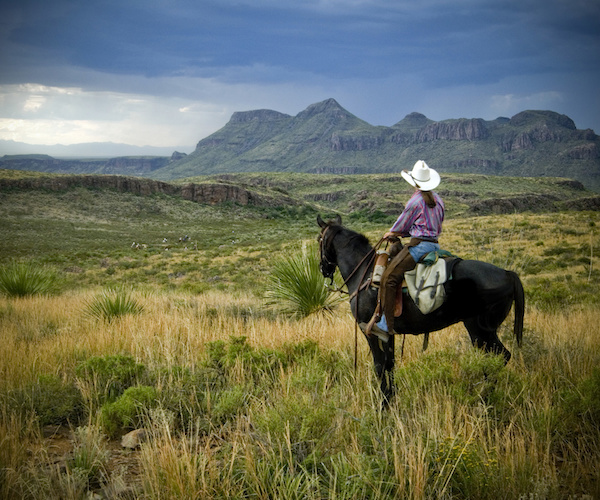
Trail riding at Big Bend Ranch State Park. Photo Courtesy Texas Parks and Wildlife Department © Chase A. Fountain
Find out more about Big Bend Ranch State Park.
Hill Country State Natural Area
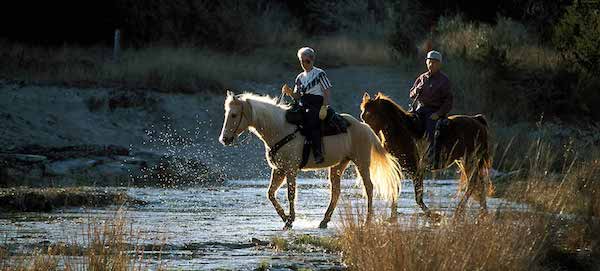
Couple trail riding through a spring in Hill Country State Natural Area. Photo Courtesy Texas Parks and Wildlife Department
Located outside of San Antonio, in Bandera, Texas, the Hill Country State Natural Area is home to 5,400 acres and 40 miles of multi-use trails. The terrain ranges from flat creek beds to canyons, reaching an elevation of 2000 feet, and contains flowing springs and grasslands throughout the land.
Many plant and animal species reside in the Hill Country. You will certainly see deer and squirrels, and it is not uncommon to see armadillos, raccoons, and rabbits.
When bringing your horse, the state park requires that you provide a current Coggins test. Hill Country State Natural Area charges a six-dollar entrance fee per day, and provides their day-use riders with trailer parking and hitching posts. Well water is provided for horses, but they advise that riders bring their own drinking water.
For an overnight stay, there are three housing options for riders and their horses. Chapa’s Group Camp is a ten-acre group campsite, accommodating a nine-stall barn with concrete floors and electricity. At the Trailhead Campground, there are six equestrian campsites with picnic tables, fire rings, pens and water for two horses, and two 40-foot length spots for trailers. There is also a group lodge that sleeps 12, with four bedrooms, 1.5 bathrooms, a kitchen, air conditioning and heat. It also contains five stalls and two pens and corrals for the horses.
If you do not have your own horse, Hill Country State Natural Area has partnered with guide service providers for rental horses and guided tours. These include, Bandera Historical Rides, Bar-B Stables, Hill Country Equestrian Lodge, Juniper Hill Stables, Outlaw Outfitters, and Rancho Cortez Guest Ranch.
Find out more about Hill Country State Natural Area.
Palo Duro Canyon State Park

View of Palo Duro Canyon. Photo Courtesy Texas Parks and Wildlife Department © Earl Nottingham
Palo Duro Canyon State Park is located in Canyon, Texas, and is home to 1,500 acres of semi-rough mountainous terrain. As the second largest canyon system in the U.S., Palo Duro Canyon stretches about 120 miles long and 20 miles wide.
Palo Duro Canyon is home to a variety of animals, such as white-tailed deer, mule deer, reptiles, and wild turkeys. Two threatened species, the Palo Duro Mouse and the Texas horned lizard also reside here. The canyon floor supports multiple types of plants, including mesquite trees, willow trees, wildflowers, sunflowers, and prickly pear cactus.
There are 1,500 acres set aside for horseback riding, and ten equestrian campsites for overnight trips. Each site holds a maximum of eight people, and includes picnic tables, fire rings, and two water faucets. However, only four of the campsites contain four joined horse pens that hold two horses per pen. Riders are allowed to bring portable panels for those campsites that do not have pens. RV’s are allowed, but there is no available hook-up or electricity. However, bathrooms and showers are located near the campsites.
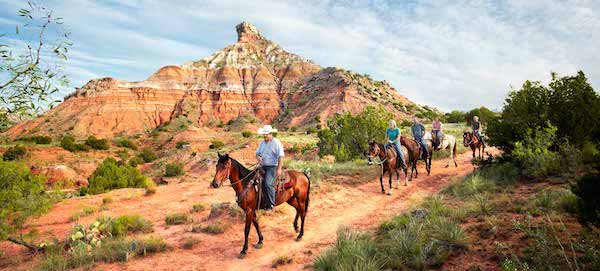
Guided trail ride through Palo Duro Canyon State Park. Photo Courtesy Texas Parks and Wildlife Department © Thomas L. Pantin
Find out more about Palo Duro Canyon State Park.
Sea Rim State Park
If you’re looking for a new kind of trail ride, head down to Sabine Pass, Texas and take a stroll along the 5.2-mile Gulf Coast shoreline of D. Roy Harrington Beach.
Day use only costs three-dollars for adults, while children under the age of twelve are able to get in for free. Sea Rim State Park is a very primitive state park, and was devastated during Hurricane Ike in 2008. Still undergoing recovery, the park does not provide many options for group housing. Riders and their horses are allowed to stay overnight on the beach. However, there are no pens or corrals set, and owners must provide a way to confine their horse overnight. Riders are allowed to bring portable panels if they wish.
Sea Rim State Park also contains 4,000 acres of marshlands for kayaking and other water activities. Horses and other animals are not allowed in the marshlands, for safety purposes.
While the number of trails and acreage for horse riders is more limited at Sea Rim State Park, the Gulf views and relaxing experience set this state park apart from all others. Strolls along the shoreline, along with watching the sun rise and set over the ocean are great ways to unwind and enjoy your time with your companion.
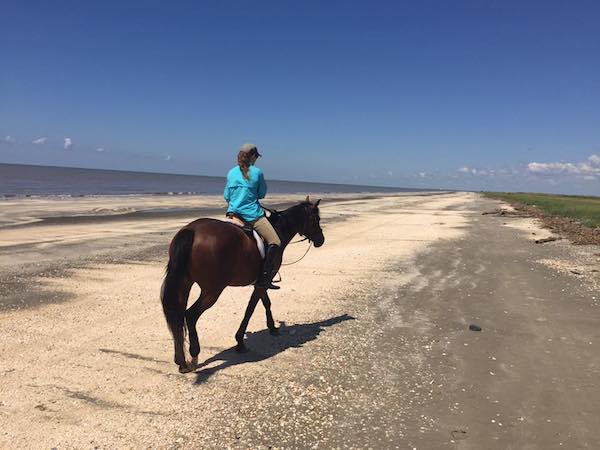
Mid-day trail ride along the shore at Sea Rim State Park. Photo © Sea Rim State Park
Find out more about Sea Rim State Park.
Texas has an endless amount of excellent trail riding areas for horses and their riders. The highlights above are just a few of the many state parks available for horseback riding. More can be found on the Texas Parks and Wildlife official website.
About the Author: Madeleine Davis is a college student at Texas A&M University, studying Animal Science and pursuing an Equine Certificate. Having ridden and competed Arabians since the age of seven, she has a passion for the Arabian horse, and enjoys writing about her experiences and knowledge of the industry.




